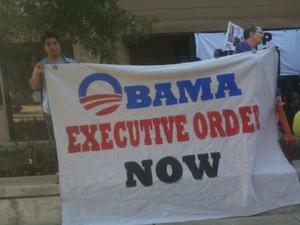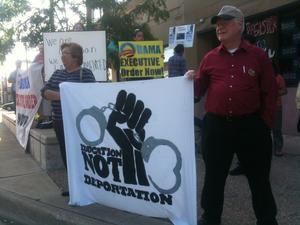After years of inaction and mounting pressure, President Barack Obama has finally issued an order to end deportation proceedings against undocumented youth who might have qualified for relief under the presently-defunct DREAM Act.
Yet while many are celebrating this move, there is reason to remain skeptical about the administration’s commitment to follow through on this immigration promise. After all, it was just a year ago this month that John Morton, the director of Immigration and Customs Enforcement, issued a memo to all I.C.E. prosecutors instructing them to use their discretion to grant “deferred action” for those individuals identified as “low-priority” according a clear and specific set of guidelines, including those who have immediate family members who are U.S. citizens, those who lack a criminal record, and those who’ve built considerable ties to their communities. Yet as Joseph Nevins has recently commented on this blog, rather than offer relief, this move has so far resulted in the closure of less than 2% of the 300,000 deportation cases reviewed by the agency. The disconnect between what the administration says and what it does regarding immigration relief has disappointed advocates and left tens of thousands of families permanently torn apart, with rates of relief falling from 26% prior to the June 2011 “Morton memo” to just 5% since.

Obama’s decision to grant relief to DREAM Act-eligible youth came only after undocumented activists from across the country forced his hand through a courageous, targeted direct action campaign. In Denver, Colorado on June 5 a group of young people occupied an Obama For America campaign office, launching a seven-day sit-in and hunger strike that inspired similar actions this past week in Georgia, California, Ohio, and Michigan—where on Wednesday, June 13, a group of undocumented youth and supporters took over Obama’s Dearborn campaign office, vowing to stay indefinitely until the president issued an executive order halting deportation against all DREAM Act-eligible youth. In response to this action, campaign workers locked all the doors, shut off the power and vacated the premises, isolating the DREAM students inside. Yet dozens have returned every day to rally outside. As one supporter told me outside the Dearborn sit-in: “We’re tired of waiting around for something to happen. Obama has to win the Latino vote to win re-election. But for the past two years he has done nothing to support us.” As this direct action campaign gained momentum, the president’s team clearly decided they needed to act.
But the DREAM Act-eligible youth are just the tip of the United States’ deportation iceberg. Under Obama the United States has detained and deported a record number of people, totaling more than 1,000,000 people in 2009, 2010 and 2011 alone. This is more than twice the rate of deportation under President George W. Bush; and it is more than 12 times the number of people rounded-up and deported during the INS’s infamous “Operation Wetback,” a racially-driven mass deportation of Mexican immigrants and Mexican-Americans in the 1950s, or roughly an “Operation Wetback” every three-and-half months during Obama’s tenure in office.
On top of this deportation juggernaut, the U.S. Supreme Court is likely to rule any day now on Arizona’s SB 1070, the extreme anti-immigrant law that has inspired similar measures in Utah, Georgia and Alabama. But although the U.S. Justice Department filed suit in 2010 to try to block some aspects of the law, SB 1070 itself was in large measure designed to mirror federal programs that the Obama administration has embraced and/or expanded, such as 287 (g) and “Secure Communities.” Across the country, these policies produce fear among immigrant communities that random traffic stops or other encounters with local law enforcement may lead to permanent separation from their homes and loved ones—fears that are themselves substantiated by heightened incidences of racial profiling against U.S. citizens and immigrants alike.
The National Immigrant Youth Alliance, a group that this week coordinated the sit-ins at Obama campaign offices, issued a statement shortly after the administration’s June 15 announcement, vowing to “maintain our present office occupations until any proposed policy change goes into effect” in light of the fact that “prosecutorial discretion has yet to be implemented.” The NIYA statement continues: “If it does not go into effect fully after 60 days and provide sufficient protection for undocumented youth, we will resume occupying the offices. We wil l also have zero tolerance for undocumented youth who enter deportation proceedings in the interim.”
l also have zero tolerance for undocumented youth who enter deportation proceedings in the interim.”
The pressure is on, and as the statement above indicates, the young peoples’ singular demand is clear: not one more deportation of DREAM Act-eligible youth. Will the administration follow through on its promises? Or will it once again say one thing publicly, while at the same time allowing its deportation juggernaut to proceed unchecked? It is too soon to say. But in Dearborn, Michigan, undocumented youth have announced that they plan to continue their occupation of Obama For America’s offices. Jose Esquivel, one of the undocumented youth participating in the action, said: “I know the risk I am taking... I am risking my life because I am tired of seeing my community live in fear. I am tired of President Obama speaking words. Our communities need action.”
Geoffrey Boyce is a writer and activist whose work focuses on immigration, border enforcement and homeland security. He is also a graduate student at the School of Geography and Development at the University of Arizona in Tucson.
For more from the Border Wars blog, visit nacla.org/blog/border-wars. And now you can follow it on twitter@NACLABorderWars. See also "Undocumented, Not Illegal: Beyond the Rhetoric of Immigration Coverage," by Angelica Rubio in the November/December 2011 NACLA Report; "The Border: Funneling Migrants to Their Doom," by Óscar Martínez, in the September/October 2011 NACLA Report; and the May/June 2007 NACLA Report, Of Migrants & Minutemen.

